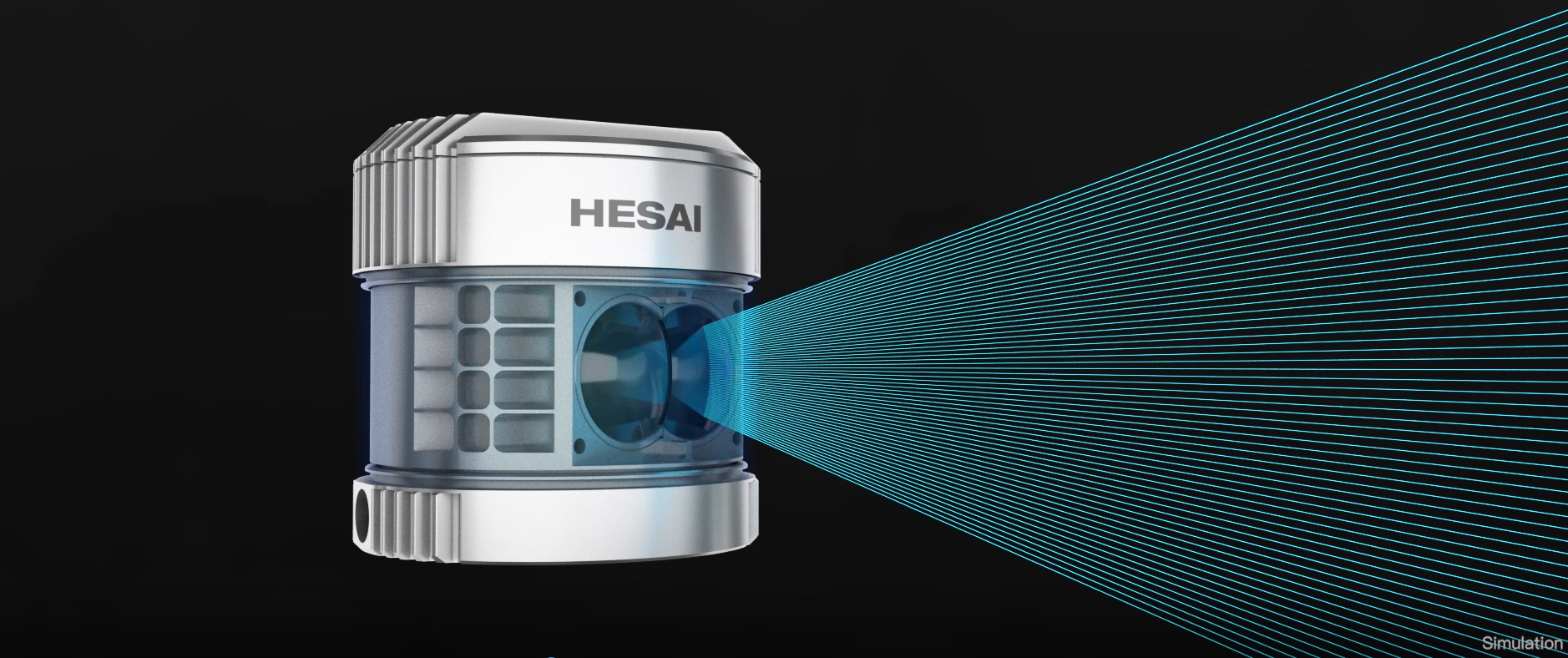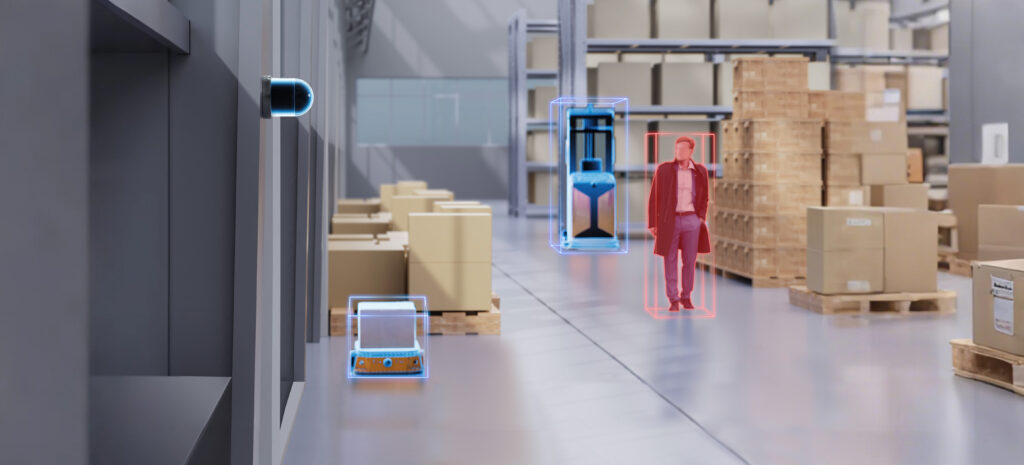
In December 2018, Hesai Tech released Pandar40P – the flagship version of Pandar40. This upgrade is marked by three key features:
1. Interference Rejection
2. Extended Range
3. PTP Synchronization
Point cloud captured by the Pandar series LiDAR
In April 2017, we brought to the world Pandar40 to break the global monopoly on LiDAR. Ever since then, HESAI Pandar40 has won over self-driving car companies and robotics companies worldwide with its superior performance and reliability. A spectrum of autonomous vehicles, from robo-taxis, delivery vehicles, sanitation vehicles to self-driving trucks, have adopted Pandar40 to enhance perception, reduce cost, and enable mass production.
Lyft’s test vehicle with HESAI Pandar40 on top
While it is no surprise that import substitution is under way for Chinese customers, a number of overseas customers are turning to Hesai as well. Of Pandar40’s global shipments, 70% go to the US, Europe and Southeast Asia.
Global reach of HESAI products
Take Silicon Valley, for instance. Of the 62 companies in California with self-driving car test permits, over 1/3 are Hesai’s customers, including many of the industry’s top players such as Lyft, Nuro, drive.ai, Roadstar.ai, TuSimple, and AutoX.
HESAI Pandar40 mounted on an autonomous car from drive.ai
For over a year, Hesai has been expanding production, improving product performance and automotive-grade reliability. The year 2018 has been a great opportunity to learn and take advice from world-class OEMs and Tier 1s as well as pioneering self-driving car companies. In our efforts to polish the product to perfection, we have pushed the boundaries of existing technologies, trying solutions previously deemed “impossible”. Now comes Pandar40P, the official upgrade of Pandar40. This additional letter incorporates all the cutting-edge innovations Hesai has made on mechanical LiDARs.
Critical Feature One: Full Interference Rejection – for a Justified Concern
LiDAR as an active light source has obvious advantages, such as robustness to ambient light and unaffected performance in the dark. Meanwhile, the interference between units has become a Damocles’ sword for the industry. LiDARs measure distance by repeatedly sending and receiving laser pulses. Upon receiving the pulses sent by nearby LiDARs, the vehicle’s point cloud will be polluted by a jumble of fast-moving noise points (a.k.a. Unidentified Flying Objects). This erroneous perception of nonexistent obstacles can result in blunders in self-driving decisions.
Point cloud: two LiDARs without interference rejection, placed 1 m from each other
At this moment, no mass-produced LiDAR on the market supports full interference rejection. (Note: Waymo has not disclosed much public information on its self-produced LiDARs.) Then why does this interference problem sound new? Because autonomous test vehicles are still few and far between – insignificant in number and scattered geographically, operated by several companies. Typical test scenarios rarely involve encounters of multiple self-driving cars, but as test fleets expand and multi-LiDAR configuration gains popularity, interference will become a major pain point.
What are the consequences of using LiDARs susceptible to interference?
1. Pressure on the point-cloud processing algorithm skyrockets
Some believe that the noise points introduced by interference can be modeled and removed with a filtering algorithm. Theoretically, yes, but still a dilemma in practice: LiDARs receive interference signals from different models and different brands of counterparts. Applying a filter for each model is going to inundate the algorithm, while a simple universal filter will distort the original point cloud, causing unwanted errors.
2. “A ticking time bomb”
In the safety-critical world of autonomous driving, so much of the work is not about improving a 60% safe product to 80%, but cutting down the accident rate from one millionth to one billionth. For a LiDAR system without full interference rejection, incidents will happen with a certain probability, however much is done at the algorithm level. Worse yet, this probability will not go down with road test mileage and may even increase as more self-driving cars hit the road. In other words, this systematic defect is a ticking bomb.
For avoiding interference between multiple LiDARs on the same vehicle, two mainstream solutions exist:
1. Change the relative positions
Either mount the LiDARs on different levels or put partitions between them.
When LiDARs are placed on different levels, their beams, either direct or reflected, will not reach each other.
Diagram 1
Partitions also work by preventing the reception of direct and reflected laser beams.
Diagram 2
2. Phase control
Avoid the reception of direct laser beams by fixing the phase difference (i.e. the angle difference of beam directions) between two LiDARs.
Diagram 3
As shown above, when two LiDARs maintain a phase difference of 90 degrees, the probability of interference by direct beams is considerably lowered.
However, these methods do not apply to interference from LiDARs on other vehicles.
Interference happens when two vehicles are in proximity to each other, whether driving in the same or opposite directions. In the future, as self-driving cars populate the roads, interference-induced motion planning errors and brake slamming could be a frequent hazard.
Hence, we endeavored to solve the problem at its root – to build LiDARs fully immune to any interference. Easier said than done. In previous iterations that increased point cloud density and measurement range, the system design was already optimized to the fullest. In that situation, we were bold enough to take a LiDAR’s signal transceiver system to the next level.
It has been more than a year of trials and testing. Now, at last, we are proud to announce that Hesai has successfully achieved full interference rejection, and the technology has become a standard production feature since August 2018.
Working Principle of Full Interference Rejection
In short, every beam emitted from every Pandar40P unit has a code. Only beams with this specific code will be accepted and displayed in the point cloud. Unmatching beams are otherwise rejected.
Below are the point clouds produced by two adjacent LiDARs at the same moment – one Pandar40P and one LiDAR without full interference rejection. Clearly, Pandar40P is free from noise points while the other LiDAR suffers significantly.
Point Cloud: with interference rejection (compressed in scale)
Point Cloud: without interference rejection (compressed in scale)
Point Cloud: with interference rejection (enlarged in scale)
Point Cloud: without interference rejection (enlarged in scale)
Critical Feature Two: Measurement Range – Further, and with Stunning Details
From 200 m @20% to 200 m @10%
Measurement range is the most important and most sought-after factor for LiDAR products in self-driving applications.
Nuro’s driverless car with HESAI Pandar40 on top
Several great things happen with range improvement from 200 m @20% to 200 m @10%.
1. See further and drive faster with safety in mind
It is a momentous leap: for objects with a reflectivity of 10% (such as dark cars), the effective detection range extends from 141 to 200 meters. For self-driving cars, it means earlier detection of obstacles and a boost in the maximum allowable driving speed, unlocking more self-driving scenarios.
AutoX using HESAI Pandar40
2. More details and higher system reliability
Better ranging performance also means better perception of near-field objects. As seen in the point clouds below of a street intersection, Pandar40P reveals much greater details for mid-range, low-reflectivity objects (such as asphalt and black tires) than Pandar40. Actually, the former has 75% more effective points in the 100-150 m range than the latter.
A perception system using Pandar40P benefits the algorithm team as well, because 75% more effective points can directly translate into higher system accuracy and robustness.
In brief, the extended measurement range allows for more effective points of mid-field objects and earlier detection of far-field obstacles, ultimately enhancing the overall safety of self-driving cars.
Critical Feature Three: PTP – Shared Time Source among LiDARs
Pandar40P supports Precision Time Protocol (PTP) for time synchronization. Using PTP eliminates the need for external timing devices, reducing the total number of cables.
HESAI MF Factory
Pandar40P has gone through a long series of iterations and reliability tests, now reaching stable performance and volume production capacity. Hundreds of prototypes have been mounted on customers’ test vehicles and have received widespread acclaim.
Pandar40P ready for shipping
For more product information and free road-test data, please visit Hesai’s official website: www.hesaitech.com.



